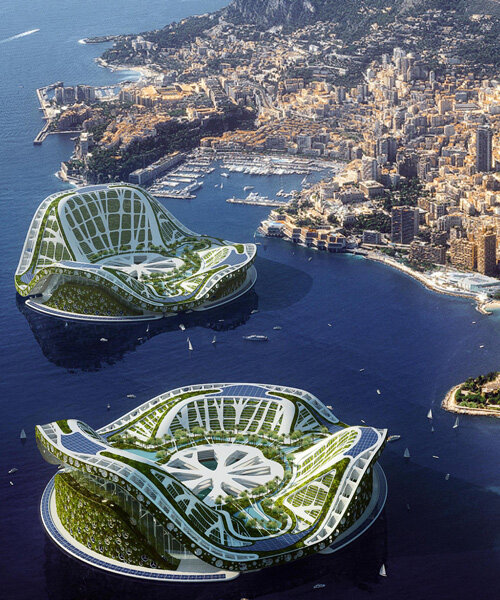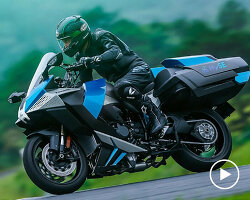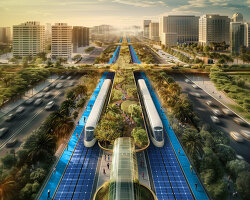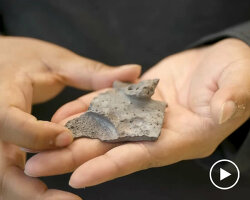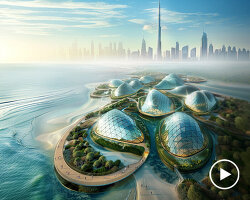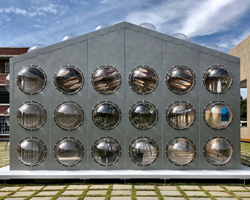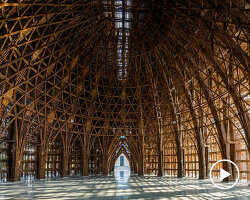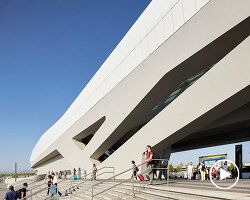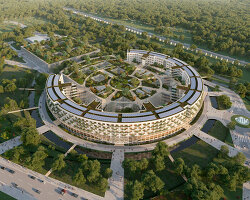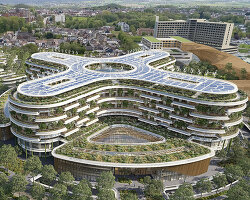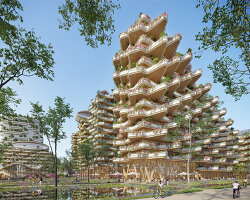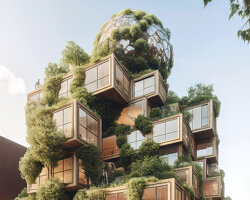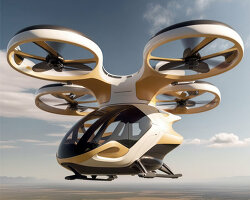since we first featured his work in 2009, vincent callebaut has designed all manner of environmentally sustainable structures — from a whale-shaped vessel that cleans the waterways of europe to a 3D-printed ‘oceanscraper’. now, callebaut and his team are beginning to see the fruits of their work with projects under construction in all corners of the globe. from dubai to taiwan, callebaut has teamed up with clients that share his vision — a process the architect describes as ‘exhilarating’. ‘when a client believes in you and empowers you to achieve exemplary goals, you’re ready to move mountains for them,’ callebaut tells designboom in this exclusive interview.
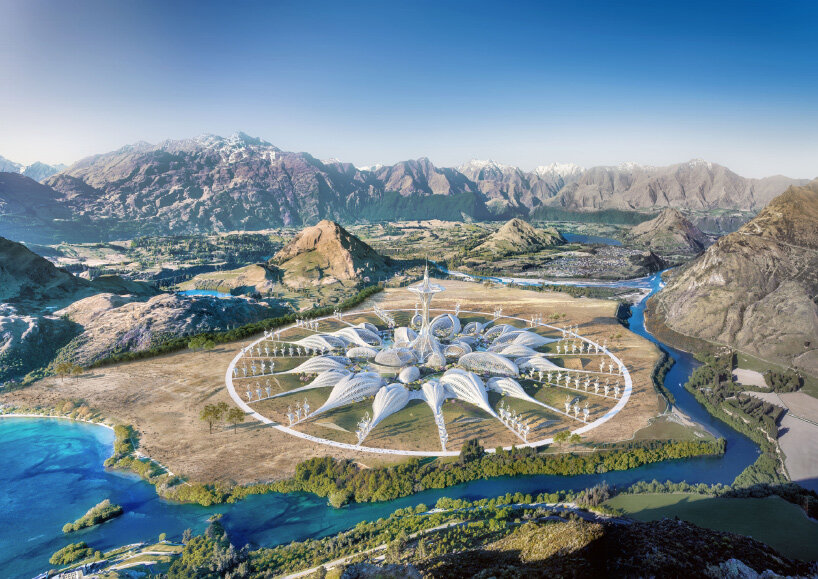
the european commission’s pollinator park, 2021 | read more on designboom here
over the past 12 years, vincent callebaut has embraced his role as an ‘archibiotect’ — a term which covers the fields of architecture, biomimicry, and technologies concerning information and communication. ‘being an archibiotect is like being an haute couture designer,’ the paris-based architect explains. ‘it is inventing spaces that dress you and closely embrace your body like a garment to optimize your quality of life and magnify your emotions, always connected with nature.’
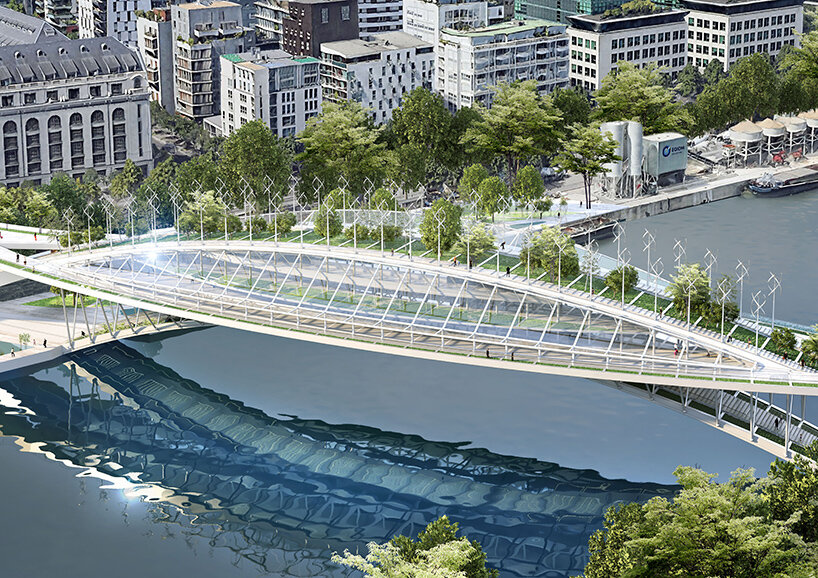
the green line, 2018 | read more on designboom here
for callebaut, the pandemic, combined with the threat of climate change, has only accelerated the need for urban centers that are more in tune with the natural world. ‘it is the challenge of my generation of architects to invent new ecological, united, and inclusive ways of living,’ he continues. in our interview, callebaut discusses how to achieve resilient and ecological urban planning, and why he thinks the current plans to rebuild the notre-dame cathedral in paris are a ‘missed opportunity’. read the interview in full below.
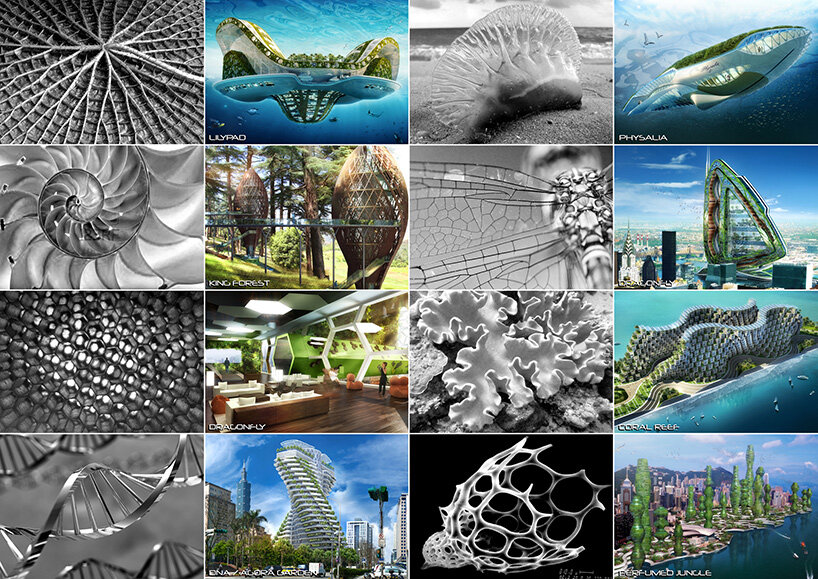
biomimicry plays a huge part in VCA’s projects
designboom (DB): you refer to yourself as an ‘archibiotect’. can you explain how this influences your approach to design?
vincent callebaut (VC): ‘ARCHIBIOTIC’ is the title of my second architectural monograph published in 2008 by ‘the united asia art and design cooperation’ in beijing. it is a neologism which, in my opinion, brings together the three vectors of contemporary urban creation in the 21st century: ARCHItecture, BIOmimicry, and TIC (technologies of information and communication). when this book came out, TIME magazine optimistically baptized me as the ‘archibiotect imagining fantastical projects that address the worlds environmental and social ills’. since then, I have not stopped developing a new transdisciplinary approach to architecture by building bridges between, on the one hand, fundamental research developed in universities and scientific laboratories, and, on the other, industrial research applied on site.
given the health crisis that is sounding the alarm bells in the wake of climate change, the concept of ARCHIBIOTIC has never been so in tune with its time. in fact, in 2021, each citizen wants to get closer to nature and is interested in biomimicry, so they can build the post-carbon, post-fossil, post-nuclear, and post-insecticide world of tomorrow. despite this thirst for nature, we are all a little schizophrenic and addicted to information and communication technologies, which have created the recent explosion of teleworking, the development of connected objects, and, above all, the constant exchange of information via big data. in short, the engineering and circular economy developed by nature for 3.8 billion years and the engineering developed by humanity for 50 years have become ultra-complementary. the leitmotiv of 21st century archibiotects is to transform cities into ecosystems, neighborhoods into forests, and buildings into inhabited trees. it is the challenge of my generation of architects to invent new ecological, united, and inclusive ways of living. lifestyles based on the circular economy which generate their own energy through photosynthesis, which recycle all their waste into resources, which only use bio and geo-sourced materials is exactly what a mature ecosystem like the amazon rainforest does.
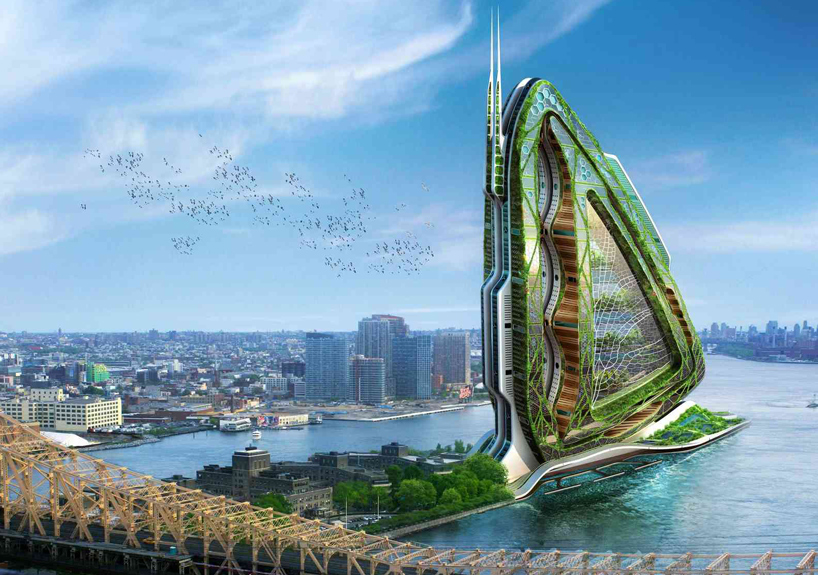
dragonfly, 2009 | read more on designboom here
DB: designboom first published one of your projects in 2009. how has your work — and the world — changed since then?
VC: I am part of the new wave of architects trained at the end of the 20th century and at the beginning of planetary awareness of the climate crisis and the rise in ocean levels. at the time, we were caught between, on the one hand, the denial of the last climate-skeptics who were alas the greatest leaders of this world, and, on the other, the warning from collapsologists announcing the collapse of our society which was unable to reinvent itself by anticipation. out came the damning reports of the IPCC and the awareness of former president jacques chirac in france and former vice-president al gore in the united states, both of whom proclaimed: ‘our house is on fire and we are looking away’. this spurred me to believe, at the age of 23 and my diploma in my pocket, that architecture and urbanism could provide many solutions in an attempt to re-tame the earth and the climate.
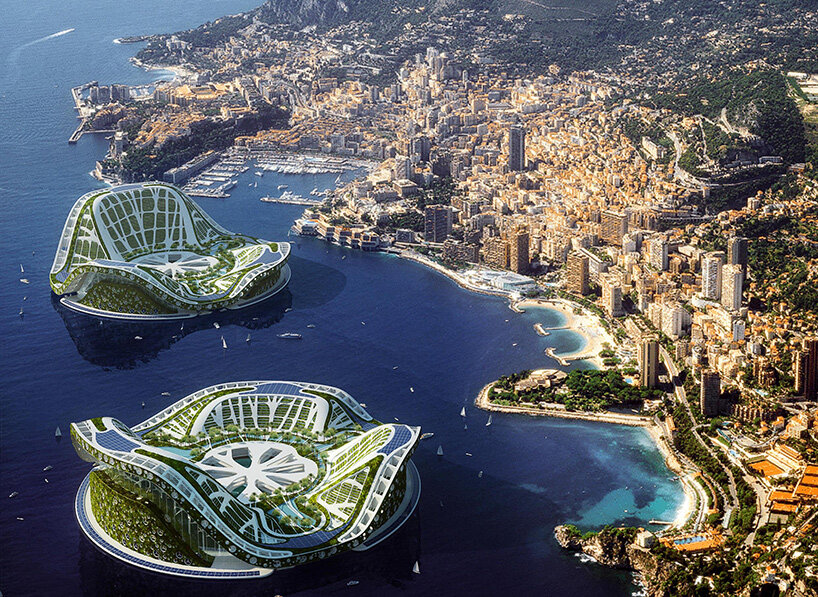
lilypad, 2008-2017
VC (continued): I then worked for months and years to design my projects, now qualified as ‘manifestos’, climatic mini-heroes who made me world-renowned, such as: ‘lilypad’, the floating city intended to welcome climate refugees whose structure, inspired by the leaves of the giant amazonian water lily, is built from green algae and recycled plastic waste from the 7th continent; ‘dragonfly’, the vertical farm in new york whose greenhouses are inspired by the crystalline structures of dragonfly wings. this project advocates the development of urban agriculture in order to reintegrate places of organic food production in short circuits in the heart of places of consumption; and ‘hydrogenase’, the vertical zepplin which offers a new generation of zero-carbon air transport running on recyclable biohydrogen rather than petroleum.
these three projects — among others — allowed me to exhibit my disruptive ideas in 2010 in a dozen national pavilions at the shanghai world expo and at the world contemporary arts fair in dubai. that’s where everything started, that’s when the agency was born 10 years ago. in these emerging countries, I found innovative entrepreneurs, eco-responsible real estate developers, and courageous politicians who trusted me and my transdisciplinary team by inviting us to numerous international competitions and/or by ordering real ecological projects from us so that we could transform concept into a built reality. today, we must constantly overturn the traditional toolkit of architecture. we need to imagine projects which advocate the right symbiosis of the humanity-nature balance by drawing inspiration from the forms, structures, and feedback loops that exist in natural ecosystems. each project must be studied upstream at each stage of its life cycle to be as low in carbon and as respectful of the planet as possible, from its design to its dismantling, including its construction and operation.
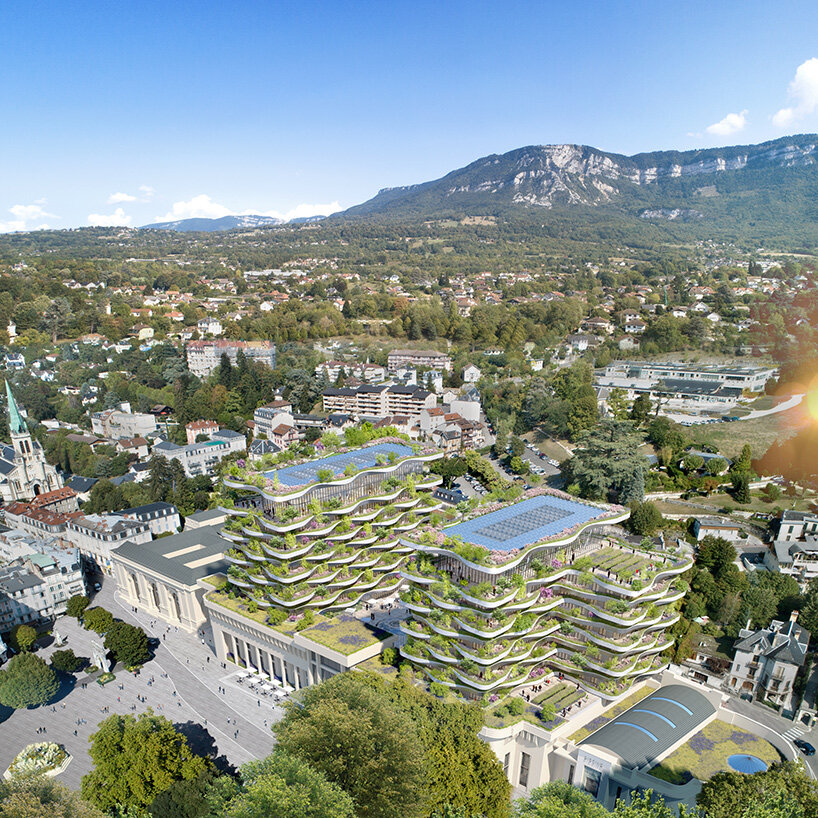
the foam of waves, 2019-2023 | read more on designboom here
DB: you now have a number of projects under construction. how exciting is it to be realizing some of your designs?
VC: today we are delivering several projects built in south east asia, the middle east, and europe. it’s very exhilarating to resonate with the times. all these projects share the desire to limit their environmental footprint and increase the quality of use of the inhabitants. all are led by pioneering clients, and when a client believes in you and empowers you to achieve exemplary goals, you’re ready to move mountains for them!
in europe, we are currently leading several major urban renewal projects such as the ‘réhabilitation des anciens thermes nationaux’ (rehabilitation of the old national baths) in aix-les-bains, a project classified as a historic monument in savoy, france. it is a question of magnifying the national heritage while advocating the development of a new typology of habitat, ‘sky-villas’, which repatriates all the advantages of living in the countryside with a private garden for each one but in the heart of historic city close to all services. each apartment thus benefits from a large vegetated balcony which brings nature to the heart of the city and allows inhabitants to admire the sublime alpine landscape between lac du bourget and mont revard.
the project, ‘the foam of waves’ laureate of the public consultation, aspires to make the heart of the thermal city of aix-les-bains vigorously beat by magnifying with a contemporary architecture this fabulous liner which, for centuries, contributed to the ‘well-being’ of aix and the city’s image. ensuring new urban continuities while stimulating a new social dynamic is the main challenge of mixed-use programming in the city center, which will be refined. the denser a city is, the less energy consuming it is. in a logic of densifying city centers, fighting the urban sprawl in europe, and waterproofing the grounds, the project is developed around the pedestrian and the porosity of the urban spaces to optimize the flows which cross the project and its new open spaces to the public. finally, bioclimatism, renewable energies, and urban agriculture are the three founding pillars of a contemporary urban approach fighting against global warming and making COP21 an applied reality. aix-les-bains will thus be able to become an exemplary model in terms of heritage eco-building oriented towards well-being.
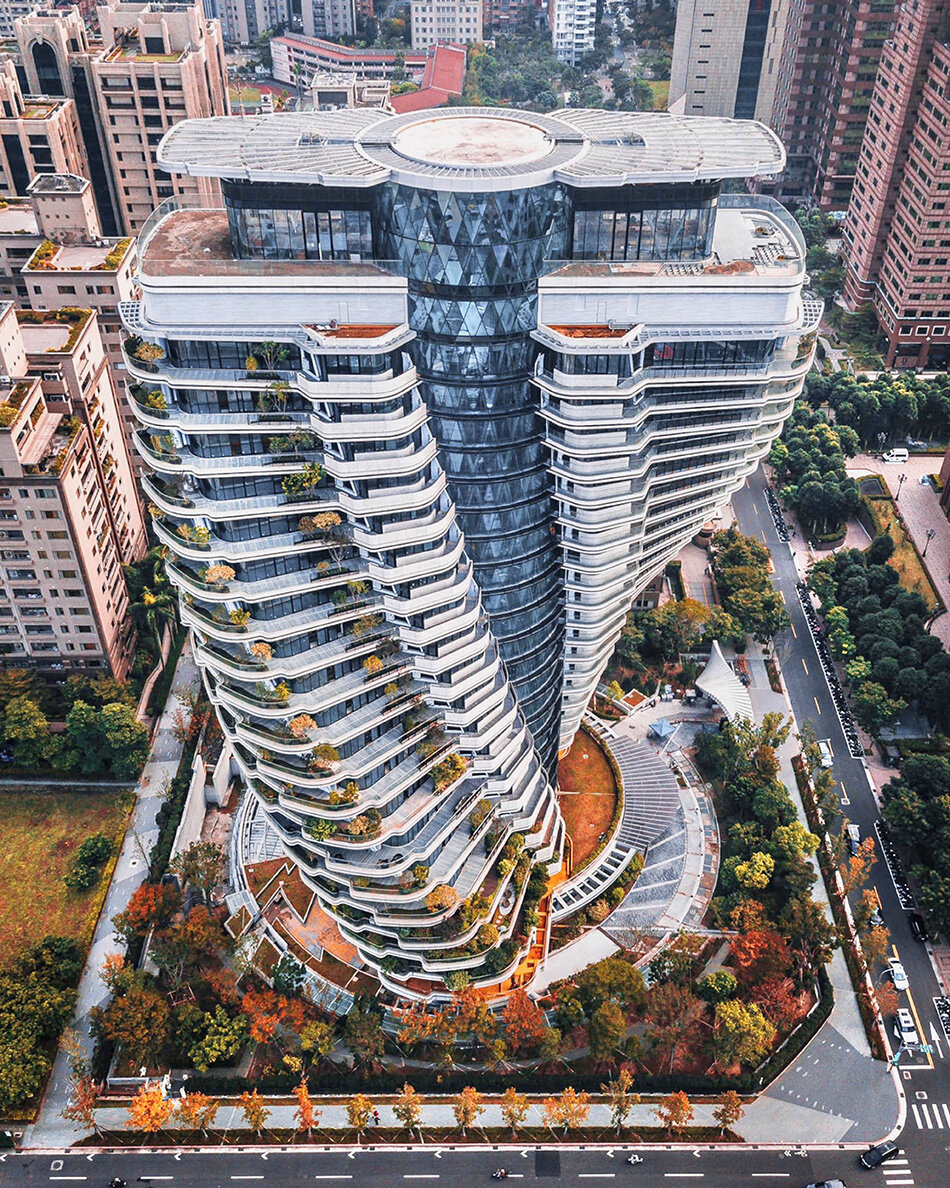
tao zhu yin yuan, 2010-2021 | read more on designboom here
DB: ‘tao zhu yin yuan’, your carbon-absorbing vertical forest, has been particularly inspiring for our readers. what were the challenges in realizing this project?
VC: ‘tao zhu yin yuan’ presents a pioneer concept of sustainable residential eco‐construction that aims at limiting the ecologic footprint of its inhabitants by researching the right symbiosis between humanity and nature. to implement symbiosis with natural environment, ‘tao zhu yin yuan’ covers its open spaces with trees, planting approximately 23,000 trees, shrubs, and plants on the ground floor garden, the balconies, and terraces of each household. the annual carbon absorption reaches around 135 tons with green coverage at 246%, which is nearly 5 times higher than local regulation, making it a colorful urban forest park in all seasons. in order to ensure the subsistence of plants in high‐rise residential buildings, we employed both sunlight and thermal analysis as well as wind and rain tests to simulate typhoons and heavy rain in taiwan. the growing plants on balconies provide oxygen, moisture environment, and mitigate the noise from surroundings. the planting is based on seasonal changes, providing shade and fresh air in the summer and warmth and ventilation in the winter.
furthermore, the tower integrates rainwater recycling, wireless monitor control of LED lighting, fiber optic connection, light guide systems, and solar/wind power to achieve energy saving and carbon reduction. to combat the problem of air pollution, ‘air purifier towers’ or ‘anti-smog towers’ like ‘tao zhu yin yuan’ are buildings integrating vertical chimneys, meaning they are centralized in the core with a double skin façade which extracts air at ground level by heating it in a specially adapted glass greenhouse at the base before letting the air pass through a series of filters and releasing clean air at the top. heating at the base of the tower is done using solar energy.
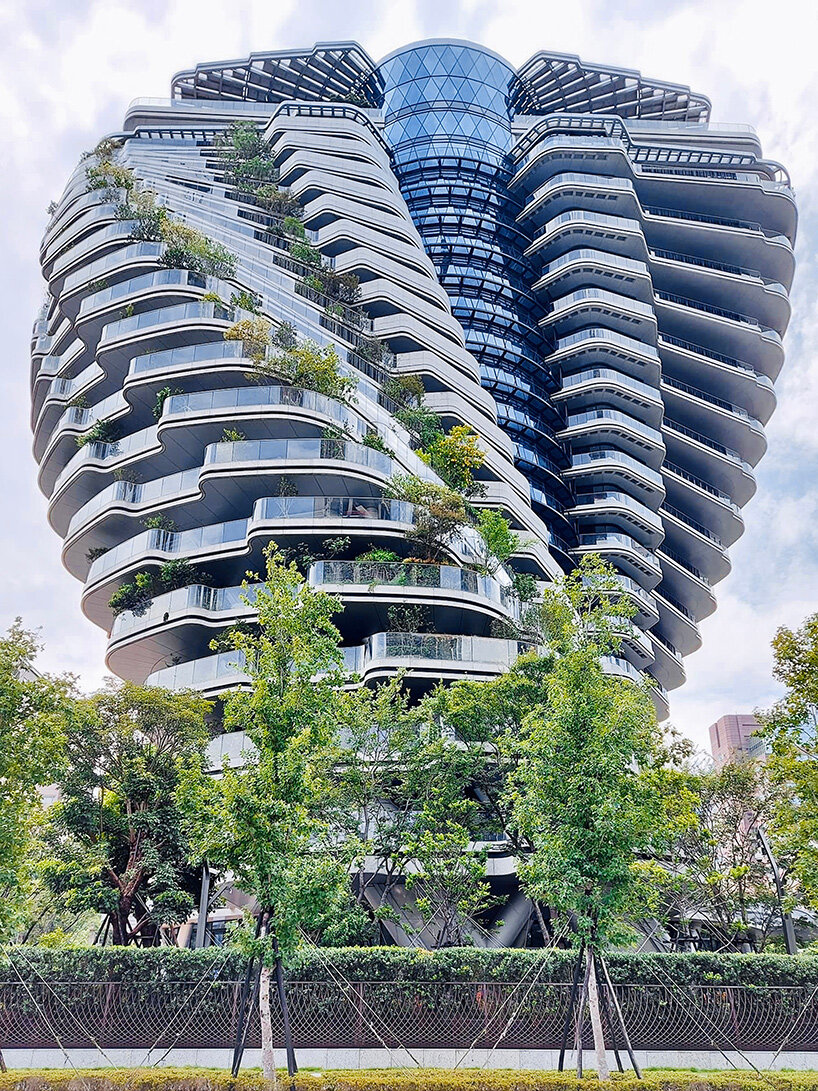
tao zhu yin yuan, 2010-2021
VC (continued): the structural design was inspired by the body structure of the skier in the design of the tower. the central core of the tower is the human body. the 5‐meter truss structure above the 21st floor are the two arms. the mega-columns on the two sides are the ski poles. a suspended structural system and a vierendeel truss system (a set of beams for every two floors) transfer all the weight via the arms (beams) to the body (central core), and then down to the foundation. the result is a one-of-a-kind structural design that combines the science of mechanics and the art of esthetics.
‘tao zhu yin yuan’ is extremely tough and highly resistant to earthquakes, ensuring the building’s sturdiness. the tower also integrates a nuclear plant-grade seismic concept. the design peak ground acceleration is 400 gal. the shock insulation design developed by the company EPS inc. (earthquake protection system) integrated under the basement floors can resist the highest class 7 earthquake (china liedu 9, surface acceleration PGA = 0.40g), and remains unharmed after the earthquake without ductile fracture. this exceeds the maximum consideration under 2,500 years return period for earthquakes as specified by seismic design specifications of ministry of interior, allowing the strength of the house to last as long as the earth’s surface.
applying the taiji concept of the unceasing cycle of life, every floor is rotated by 4.5 degrees to a total of 90 degrees for the entire tower. the design also features 270‐degree views, double‐floor design, a column‐free interior space, and column-less odd‐floor perimeters for exceptional flexibility and freedom in interior planning for each resident! innovative interior column-free design in structure allows you an even wider window view to truly enjoy the beautiful hanging gardens.
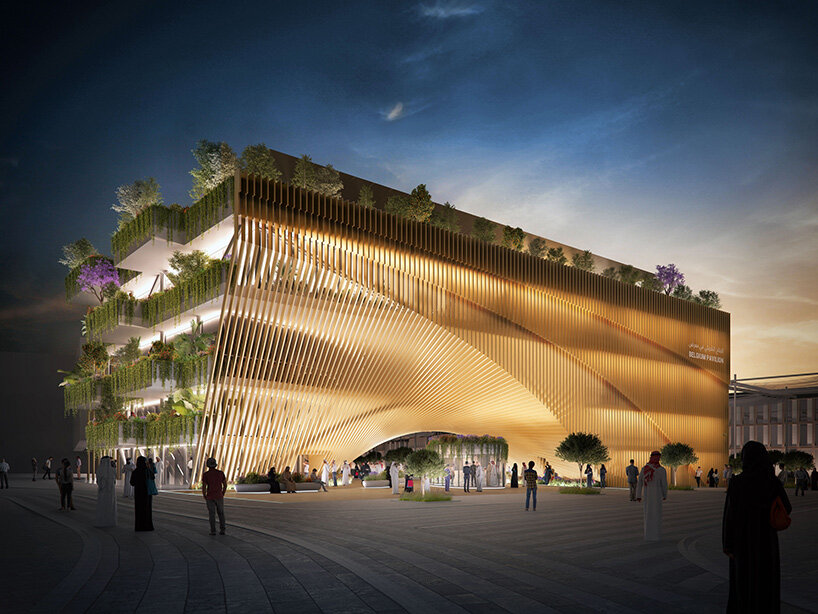
the green arch, 2021
DB: your belgium pavilion at expo 2020 will also open later this year. what impact do you hope the pavilion will have on visitors?
VC: government agency, builder, and architects have one and only one ambition: to make our country shine internationally. ‘the green arch’, the belgian pavilion at expo 2020 dubai, was intended as a non-standard ‘out of the box’ architecture which, from the first sketches, expresses the dynamism and diversity of our country. this project is a real spatialization of the concept ‘belgitude’, a clever blend of latin romanticism specific to southern europe and high pragmatic engineering from germanic and anglo-saxon countries in northern europe. ‘connecting minds, creating the future’ is the main theme of expo 2020 dubai. with our krafthaus scenographers, we have applied this leitmotif to the letter, imagining a project with a very strong identity that can be summarized in two pencil lines on a simple beer carton: a green building-bridge forming a huge wooden arch to accommodate a vast public agora protected from the sun.
the ‘green arch’ will be belgium’s showcase for six months. as an architect, we want to promote the know-how and innovations of the best belgian manufacturers and companies in all fields. the gourmet kiosks, the immersive exhibition, the brasserie, the business center, each space is carefully thought out to highlight our art of living, our gastronomy, our ingenuity, our engineering, and our ecological commitments. the ‘green arch’ will open its doors on october 1, 2021. it is a very beautiful project in a mixed steel-wood structure that is wrapped with more than 5.5 kilometers of louvers in cross laminated timber creating a big vault. the public agora will be deployed under this large spruce vault filtering the sunlight like a giant lattice. inside, visitors will be able to discover the most beautiful belgian innovations that imagine the mobility of the future in the form of comics, the typically belgian mode of expression!
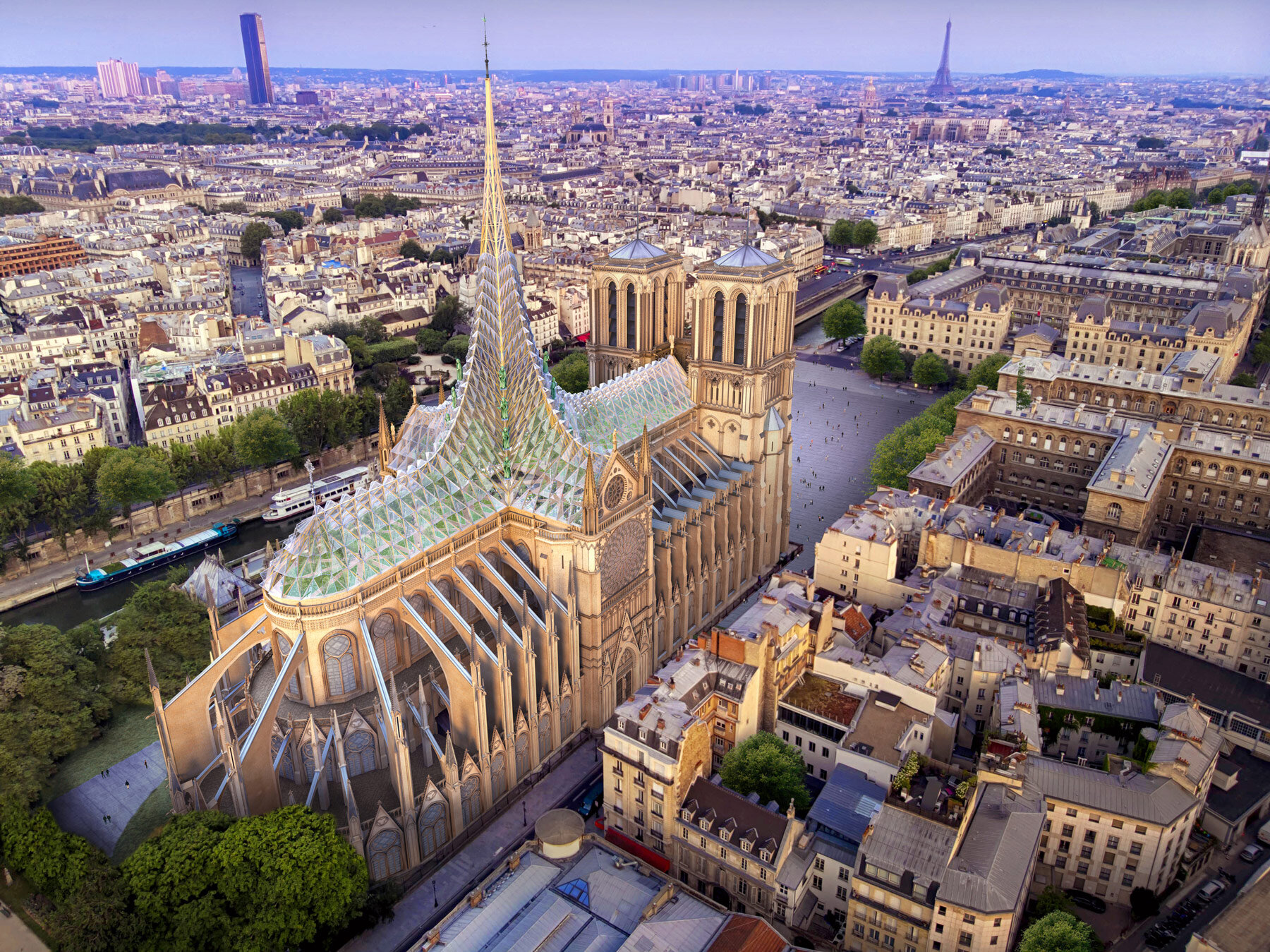
palingenesis, 2019 | read more on designboom here
DB: your proposal for the renovation of the notre-dame cathedral generated a lot of interest. were you disappointed in the decision to simply rebuild what was there before?
VC: ‘each wave of time contributes its alluvium, each race deposits its layer on the monument, each individual brings his stone. thus do the beavers, thus do the bees, thus do people’ — victor hugo, the hunchback of notre-dame (1831)
we advocate for an exemplary project in ecological engineering that feels true to its time and avoids a pastiche architecture that turns the city into an open-air museum. circular economy, renewable energies, inclusive social innovation, urban agriculture, protection of biodiversity, all without forgetting beauty and spiritual elevation: our reconstruction project feeds on such values to deliver a deep, conscious meaning. from primitive gothic in the 12th century to its restoration by viollet-le duc in the 19th century, through the radiant gothic of the 13th century and the flamboyant gothic of the 14th century, notre-dame cathedral undoubtedly arises from centuries of work and multi-faceted inspiration. as such, it is hardly encumbered by useless musings about the overlapping styles inherent in the building.
we seek to present a transcendent project, a public skygarden, a symbol of a resilient and ecological future that offers paris a set of solutions inspired by biomimicry, defined here as a common ethic for a fairer symbiotic relationship between humans and nature. our ‘palingenesis’ project — in greek παλιγγενεσία, meaning ‘rebirth’, ‘regeneration’ — aims to assimilate the venerable stone nave, blending it naturally as a vegetal graft, harmonizing in one gesture – in one single curved stroke of pencil – the roof and the spire. respecting the inherent principles of descent of the structural loads of the building towards the flying buttresses and the inner fasciculated pillars, the four roofing lines and the four lines of the roof’s ribs bend and join together in harmony towards the sky, producing a light, parametric geometry. constructed with cross laminated timber beams pre-stressed with carbon fiber slats, the new oak frame seeks to use the minimum amount of material, ensuring a low-carbon footprint while offering the greatest transparency to the cathedral. identical reconstruction is a missed opportunity to rethink the role of spirituality in our contemporary society which is losing its bearings.
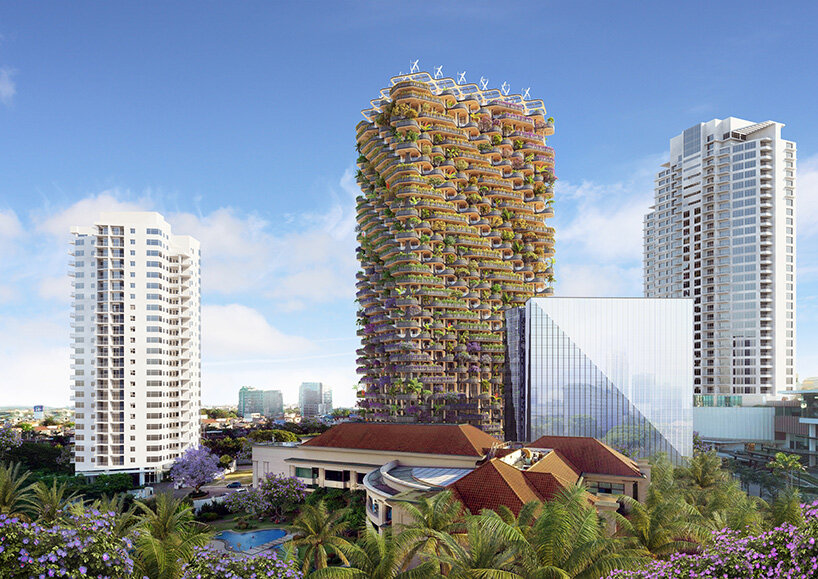
the rainbow tree, 2019 | read more on designboom here
DB: are you optimistic about the future?
VC: since the start of the first lockdown due to covid-19 on march 15, 2020, we have globally discovered our absolute need for resilience, that is to say our collective capacity to withstand a shock and come back to life like a forest after a fire. this health crisis must be seen as an extraordinary opportunity to invent a more sober, more reasoned, more united development model. any and all exemplary approaches must become the norm. facing ecological and social issues is not an option in an architectural project. this is the basis of our professional commitment. our role is to imagine eco-responsible lifestyles and then to design the architecture that allows them to be spontaneously adopted by as many people as possible — like our vertical village ‘the rainbow tree’, designed 100% in solid wood in cebu city in the philippines, or our more recent project ‘archiborescence’ to build affordable wooden housing in lille, france. we are implementing four major ‘icebreaker’ measures through our projects to achieve resilient and ecological urban planning:
1. the zero-waste circular economy: unlike our current linear economy, where we produce, consume, throw away, and create debt by plundering the earth of its resources, the circular economy is a ‘regenerative’ economy. it is based on bio-based materials, the recycling of waste into resources, and decentralized renewable energies. the circular economy systematically implements the triple ‘R’ rule: reduce, reuse, and recycle. in this new positive environmental impact economy, priority is given to short supply chains and reuse in all sectors, in particular that of construction, which emits 40% of greenhouse gases and consumes 40% of energy produced in the world. in our European cities, 90% of the buildings to be built by 2050 are already here! priority must therefore be massively oriented towards energy renovation and rehabilitation of the existing.
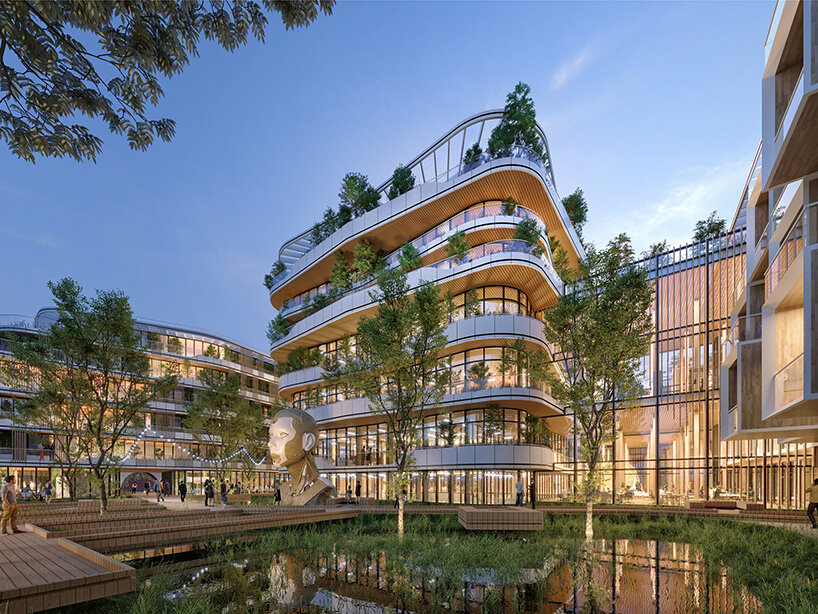
archiborescence, 2021 | read more on designboom here
VC (continued): 2. soft mobility and the fight against urban sprawl: in full lockdown, the large stressful and polluted cities very quickly calmed down and the organization of the territory was organized around proximity. in fact, the spectacular drop in CO2 emissions, waste production, and noise pollution has been beneficial for our health and well-being. we all felt it. traveling on foot and by bicycle, we learned to get to know our neighborhood, our neighbors, and our local merchants. we learned to help each other. physical distancing has intensified our vital need for social closeness based on solidarity. nowadays, to drastically reduce our business and leisure trips around the world is now obvious. the ‘zero-car’ city should no longer be a taboo and the ‘100% cycle-friendly’ city boosted by the containment dice must not remain temporary. let’s transform our neighborhoods into friendly villages bringing together all the services between family and professional life. the denser a city is, the less energy it needs. the closer the inhabitants are, the more they show solidarity.
3. biodiversity and urban agriculture: we are living in the third era of global urbanization where after having built cities on nature, then cities on/around cities, we are now repatriating nature to the city for better fight against soil waterproofing and protect our biodiversity. urban forests in the ground, agricultural towers, and urban farms reinvest in mineral towns. this intensive greening of construction has the following objectives: the creation of an urban freshness island; the repatriation of biodiversity in the heart of the city; rainwater recovery and phyto-purification; the development of urban agriculture and co-gardening.
4. agility of use/reversibility of buildings: the health crisis undeniably highlights the failure of hyperspecialization and monofunctionality of certain spaces in the city, such as the la défense district in paris. the reversibility and mutability of the infrastructures and buildings that we design are becoming essential to follow the evolution of uses such as teleworking and teleconferencing, the use of which has exploded during the crisis. this mix of uses must be found at the scale of the city, the district, and the building. In recent years, most of our projects have imagined a floor reserved for sharing between all residents of a building. a space for socializing that could also be used for future lockdowns and isolation measures in the event of a crisis.
cities consume 80% of the planet’s resources on only 2% of its area. these 4 icebreaker measures tackle the structural reasons for ecological and health crises and do not simply heal the symptoms. they are easy to implement, economically viable, and aim to build a frugal city where we have done better with less.
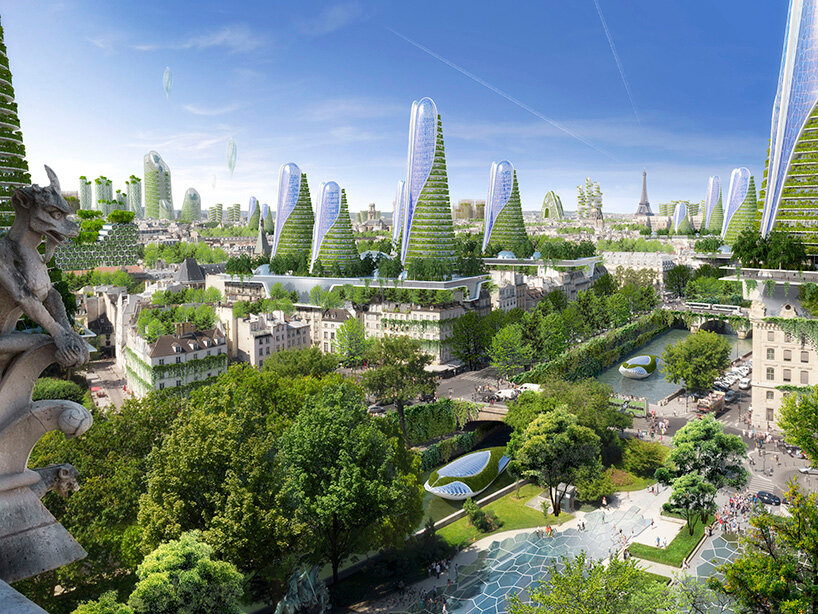
paris smart city 2050, 2014-2015 | read more on designboom here
DB: what advice do you give to today’s young architects and designers?
VC: young architects and designers can create new sustainable prototypes for a better and safer future for the environment. in these times of climatic, health, and economic crises, their collective eco-design imagination is the most powerful tool to repair our little blue planet. humanity is part of a global ecosystem. humanity is not superior to nature and should draw much more inspiration from living things through biomimicry. as a reminder, like the amazon rainforest, nature invented the circular economy. it recycles everything and transforms each waste into a resource. it uses photosynthesis as its sole source of energy. it limits the excesses coming from outside and it systematically relies on cooperation between species.
through biomimicry, we try to do the same through our architectural projects designed as metabolic ecosystems producing their own energy (calorific, cooling, electrical, and food) and recycling their waste into resources via virtuous loops. our biophilic architectures are inspired by shapes, structures, and all the feedback loops found in nature. there is no right angle, they are designed ‘out of the box’. our projects combine the best of low- and high-tech rather than opposing them as is too often done in europe.
low-tech is synonymous with sobriety and simplicity, modularity and repairability, social links and solidarity practices. it is reflected in the form of bio-sourced construction, bioclimatic co-design, and any ventilation, irrigation, heating, and lighting technique that does not require a single kilowatt for its proper functioning. high-tech brings together renewable energies and smartgrids (intelligent energy and data distribution networks) which aims to produce energy properly and reduce overall consumption and waste towards a neutral carbon footprint.
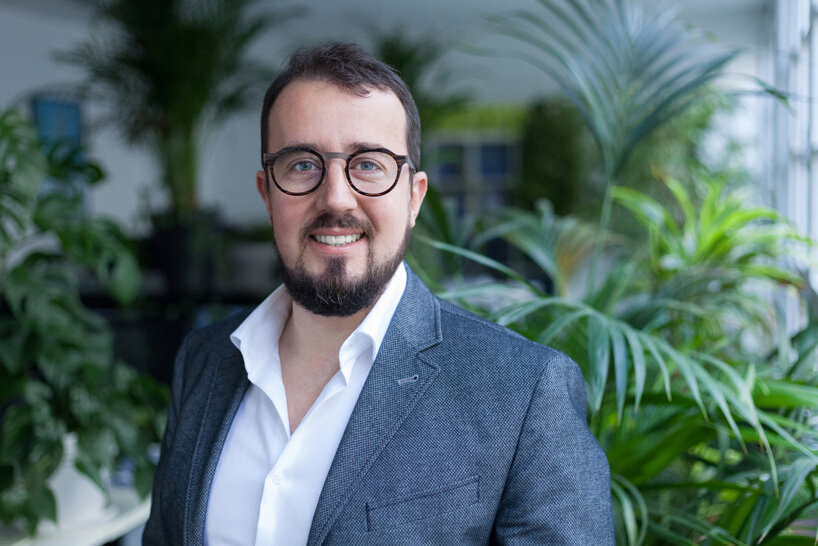
vincent callebaut | image © marine toux
VC (continued): developed for the city of paris, our ‘paris smart city 2050’ project is a perfect illustration of this low-tech/high-tech fusion. following the climate energy plan of paris aimed at reducing 75% of the greenhouse gas emissions within 2050, the ‘paris smart city 2050’ project is a research and development work on the integration of high-rise buildings with plus-energy (BEPOS) producing by solidarity all together energy for the surrounding areas. in order to fight against the urban heat-island phenomenon by increasing in the same time the density of the city in the long-term, this masterplan presents 8 prototypes of mixed towers. these towers repatriate nature into the heart of the city and use their design to integrate the rules of bioclimatism and the renewable and recyclable energies in short loops through innovative systems. turning to new social innovations, they first invent new eco-responsible ways of life to implement the quality of life of the city-dwellers in the respect of the environment. this kind of project, developed with ambitious politicians as ‘the municipality of paris’, is a big hope to create a safer and a greener tomorrow!
we live through architecture 24 hours a day: in the office, at home, during transport, in theaters, in the streets. this directly influences our health and comfort. being an archibiotect is like being an haute couture designer, it is inventing spaces that dress you and closely embrace your body like a garment to optimize your quality of life and magnify your emotions, always connected with nature. do you want to become an architect? be fiercely persevering and true to your ideals, and, as oscar wilde said so well, ‘shoot for the moon. even if you miss, you’ll land among the stars.’
architecture interviews (267)
carbon neutrality? (152)
dbinstagram (2250)
vincent callebaut architectures (37)
PRODUCT LIBRARY
a diverse digital database that acts as a valuable guide in gaining insight and information about a product directly from the manufacturer, and serves as a rich reference point in developing a project or scheme.
